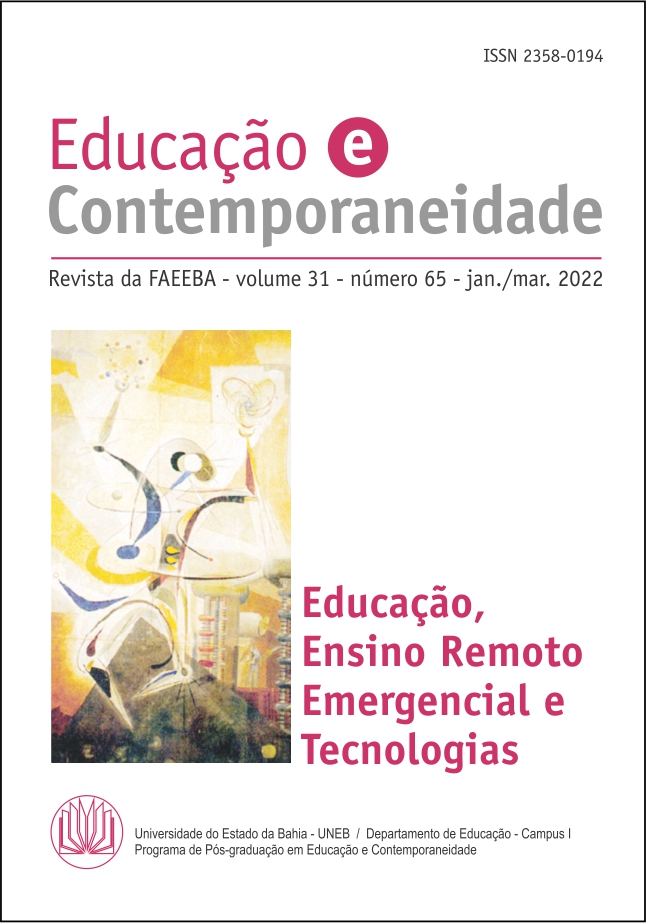Learning Choreographies in Emergency Remote Teaching:
teacher training for Vocational and Technological Education
DOI:
https://doi.org/10.21879/faeeba2358-0194.2022.v31.n65.p156-173Keywords:
Teacher training, Teaching practice, Professional Education, Digital TechnologyAbstract
This text presents the result of a descriptive and qualitative research, carried out in a continuous training course for teachers of professional and technological education, for teaching work in remote teaching. The objective was to identify learning choreographies innovative, mediated by digital technologies. 86 professors who had completed the course promoted by the School of Server Development, of a federal public institution, were invited by e-mail to participate in this research. This is descriptive qualitative research, whose data collection consisted of the researcher's participation in 04 synchronous meetings of the course and in the application of an online form to complement the results, aiming at achieving the proposed objective. In addition, didactic materials such as student portfolios, dialogues and all files posted in the Google Classroom virtual class were consulted, since due to social isolation the course was asynchronous with synchronous moments. For the synchronous moments, the Microsoft Teams platform was used. The analyzes indicate that there was a teaching learning in relation to the use of digital technologies for the elaboration of choreographies favorable to a more active, autonomous, and innovative learning.
Downloads
References
BAERISWYL F. Choreographies of School Learning. Em: Seel NM (eds) Encyclopedia of the Sciences of Learning. Springer: Boston, 2012.
CUNHA, Maria Isabel. Inovações pedagógicas: o desafio da reconfiguração de saberes na docência universitária. Universidade de São Paulo: Pró-reitora de graduação, 2008.
DEMO, Pedro. Pesquisa: princípio científico e educativo.12. ed. São Paulo: Cortez, 2006.
DENZIN, N. K.; LINCOLN, Y. S. Introdução: a disciplina e a prática da pesquisa qualitativa. In: DENZIN, N. K. e LINCOLN, Y. S. (Orgs.). O planejamento da pesquisa qualitativa: teorias e abordagens. 2. ed. Porto Alegre: Artmed, 2006. p. 15-41.
FERRAZ, Ana Paula do Carmo Marcheti.; BELHOT, Renato Vairo. Taxonomia de Bloom: revisão teórica e apresentação das adequações do instrumento para definição de objetivos instrucionais. Gest. Prod., São Carlos, v. 17, n. 2, p. 421-431, 2010. Disponível em: https://www.scielo.br/pdf/gp/v17n2/a15v17n2.pdf. Acesso em: 23 mar. 2021.
GARDNER, Howard. Estruturas da mente: a teoria das inteligências múltiplas. Porto Alegre: Artes Médicas, 1994.
GIL, Antonio Carlos. Como elaborar projetos de pesquisa. 4. ed. São Paulo: Atlas, 2008.
LUCKESI, Cipriano Carlos. Avaliação da aprendizagem. São Paulo/SP: Cortez 2011.
MORAN, José. Mudando a educação com metodologias ativas. In: Mídias contemporâneas. convergências midiáticas, educação e cidadania: aproximações jovens. SOUZA, Carlos Alberto de Souza.; MORALES, Ofelia Elisa Torres. (orgs.). PG: Foca Foto-PROEX/UEPG, 2015. Disponível em: http://rh.unis.edu.br/wp-content/uploads/sites/67/2016/06/Mudando-a-Educacao-com-Metodologias-Ativas.pdf. Acesso em: 23 mar. 2021.
OSER, F. K.; BAERISWYL, F. J. Choreographies of teaching: bridging instruction to teaching. In V. Richardson (ed.) Handbook of Research on Teaching. 4º Editon. Washington: AERA, 2001. p. 1.031-1.065.
PEREIRA, Olga Arantes. Pedagogia de Projetos. Revista de pesquisa científica – Fatea. Janus, Lorena, ano 1, no 1, 2º semestre de 2004.
SCHWAB, Klaus. The Fourth Industrial Revolution: what it means, how to respond. World Economic Forum, 2016. Disponível em: https://www.weforum.org/agenda/2016/01/the-fourth-industrial-revolution-what-it-means-and-how-to-respond/. Acesso em: 26 mar. 2021.
ZABALZA. Miguel A. Pedagogía de la Infancia para el siglo XXI: a la búsqueda de nuevas coreografías educativas. In: CAPPUCCIO, Giuseppa.; COMPAGNO, Giuseppa.; POLENGHI Simonetta. (Orgs.) 30 anni dopo la Convenzione ONU sui diritti dell’infanzia. Quale pedagogia per i minori? a cura di. Pensa MultiMedia, 2020.
ZABALZA, Miguel A. O ensino universitário: seu cenário e seus protagonistas. Porto Alegre: Artmed, 2004.
Additional Files
Published
How to Cite
Issue
Section
License
O encaminhamento dos textos para a revista implica a autorização para a publicação.
A aceitação para a publicação implica na cessão de direitos de primeira publicação para a revista.
Os direitos autorais permanecem com os autores.
Após a primeira publicação, os autores têm autorização para a divulgação do trabalho por outros meios (ex.: repositório institucional ou capítulo de livro), desde que citada a fonte completa.
Os autores dos textos assumem que são autores de todo o conteúdo fornecido na submissão e que possuem autorização para uso de conteúdo protegido por direitos autorais reproduzido em sua submissão.
Atualizado em 15/07/2017

















































